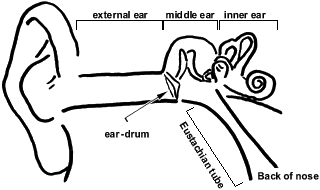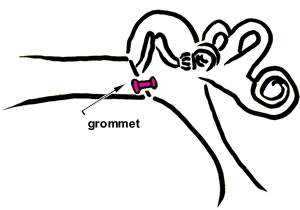 Grommet Insertion
Grommet Insertion
 Grommet Insertion
Grommet Insertion
Sound is transmitted along the external ear canal and into the inner ear by vibrating the ear-drum, which in turn vibrates the three little bones in the middle ear cavity. If there is fluid in the middle ear cavity, the three little bones cannot vibrate properly and hearing is impaired.
Middle ear infections represent a spectrum of disease ranging from recurrent acute episodes with or without middle ear fluid (acute otitis media) to prolonged episodes of persistent fluid in the middle ear cavities (otitis media with effusion). The underlying problem is that of Eustachian tube dysfunction.

The middle ear cavity is connected to the back of the nose by the Eustachian tube. A properly functioning Eustachian tube ventilates the middle ear cavity. The presence of air in the middle ear cavity is the desired situation. Have you noticed that when you travel up a hill or if you are on an aeroplane, your ears will begin to feel blocked and uncomfortable as you gain or lose altitude? Then, when you unblock your ears using the Valsalva manoeuvre (pinching your nose and blowing against the pinched nose), the ears 'pop' and you feel better. The blocked ears occur as negative pressure is produced in the middle ear cavities during the altitude change. The Valsalva manoeuvre corrects this by pushing air up the Eustachian tube and into the middle ear cavities.
Eustachian tube dysfunction tends to occur mainly in children. The Eustachian tube function may not be optimal in these children for a number of reasons, in particular the more horizontal position of the tube as it opens into the back of the nose. As these children grow, the tube lies more vertically. Older children who are prone to middle ear infections can be encouraged to do Eustachian tube exercises, for example balloon blowing exercises, to help to strengthen the Eustachian tube.
Presentation
Children with acute otitis media may present with fever, ear-tugging, irritability and sleep fragmentation. Middle ear fluid may be present and the ear-drum may perforate and release fluid into the ear canal. In this situation, despite the discharging ear, the child may feel better. On the other end of the spectrum, the children with otitis media with effusion may present only with hearing impairment with no systemic symptoms.
When is surgery indicated and what does surgery involve?
If the symptoms persist for long enough that the child is constantly unwell, and requires many courses of antibiotics, or if the child's speech, learning and development are affected, then surgical intervention is a valid option. The operation is referred to as myringotomies with insertion of ventilation tubes. These ventilation tubes are more commonly referred to as 'grommets'. The concept is to surgically drain the fluid from the middle ear cavities by making a small incision in the ear-drums and inserting ventilation tubes into the ear-drums.

These tubes are tiny and they will sit in the ear-drum to allow the middle ear cavities to be ventilated. In fact, a 'grommet' acts as a substitute Eustachian tube while waiting for the child's own Eustachian tube function to improve with the passage of time. The most common ventilation tube that is used is the Shepard's tube and this will stay in position for an average of 6 to 8 months. The ventilation tube will come out of the ear-drum by itself and will sit in the ear canal. This process is referred to as extrusion. During the next scheduled visit with the ENT surgeon, the 'grommet' will be gently removed from the ear canal and given to the child if the child wants to keep it! The ENT surgeon will also confirm that the ear-drum has healed properly.
The operation is done as a day surgery procedure and a general anaesthetic is required. The procedure, risks and benefits will be discussed in full during your consultation with Dr Para.
Outcome
While the grommets are in position, the child will cope better with upper respiratory tract infections and the hearing will be good. However when they extrude, if the Eustachian tube function has still not improved, the previous problems may recur. This does not reflect a poor outcome. Further discussion may occur regarding the potential benefits versus the risks of repeat surgery pending improvement of Eustachian tube function as the child gets older.
For information regarding your child's hospital stay, please visit ENT for Kids
Download a printable version of this information here
Back to other procedures